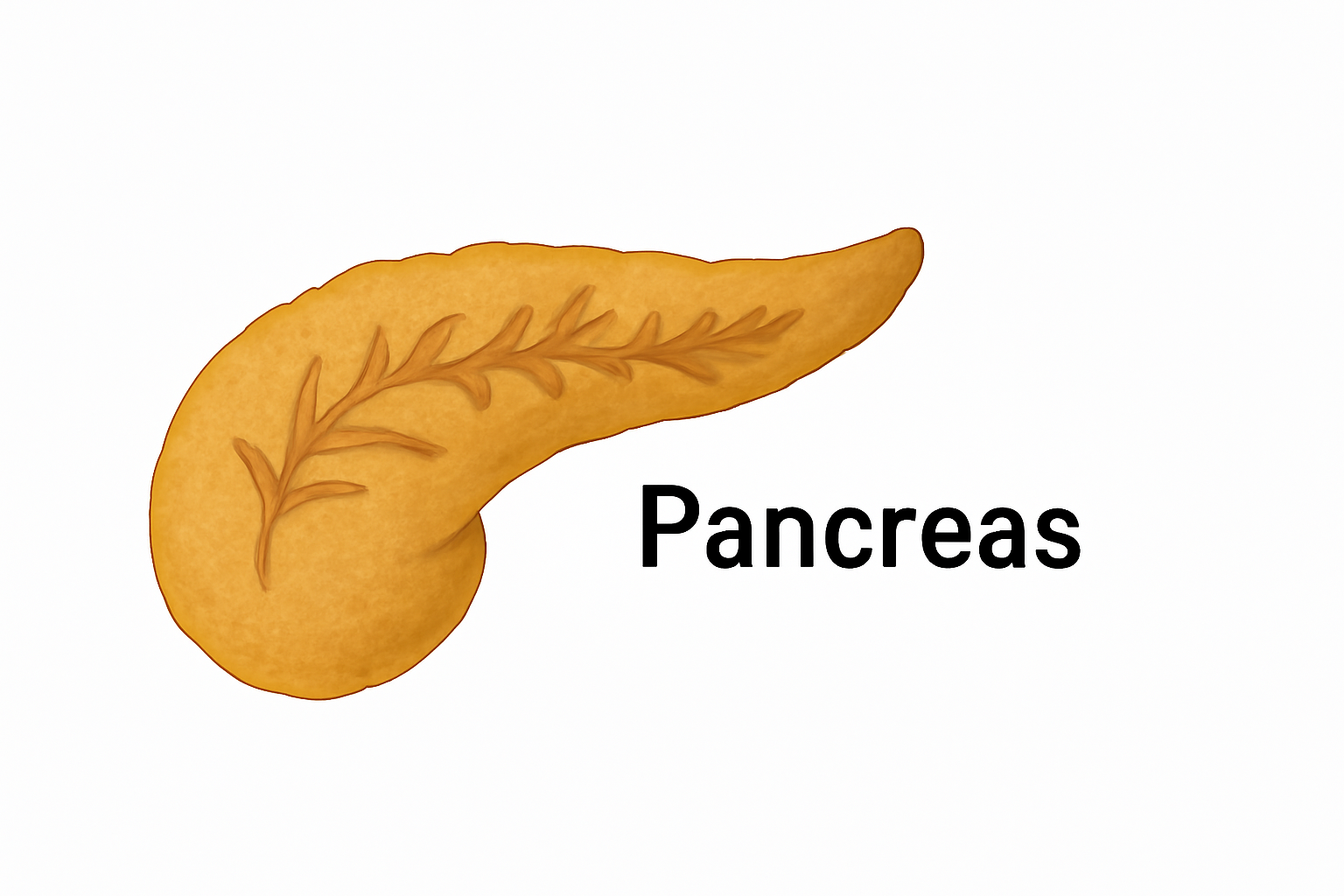Pancreatic Surgery

The pancreas is a vital organ located in the upper abdomen, behind the stomach. It is long, flat, and shaped somewhat like a fish, extending from the duodenum (part of the small intestine) on the right to the spleen on the left.
It serves two major roles in the body: digestive (exocrine) and hormonal (endocrine).
🧠 Functions of the Pancreas
1. 🔧 Exocrine Function (Digestion)
• Produces digestive enzymes that help break down food in the small intestine.
• These enzymes include:
• Amylase (breaks down carbohydrates)
• Lipase (breaks down fats)
• Protease (breaks down proteins)
• Enzymes are released into the duodenum via the pancreatic duct, often joining the common bile duct.
2. 💉 Endocrine Function (Blood Sugar Regulation)
• Produces important hormones that regulate blood sugar:
• Insulin: Lowers blood sugar by helping cells absorb glucose.
• Glucagon: Raises blood sugar by releasing glucose from the liver.
• These hormones are produced by clusters of cells called the islets of Langerhans.
⚠️ Common Surgical Conditions of the Pancreas
1. Acute Pancreatitis (Severe Cases)
• Sudden inflammation of the pancreas, often due to gallstones or alcohol.
• Surgery may be needed if there are complications such as:
• Pancreatic necrosis (dead tissue)
• Infected fluid collections or abscesses
• Pancreatic pseudocyst
• Procedures: Drainage, necrosectomy, or debridement (removal of dead tissue).
2. Chronic Pancreatitis
• Long-standing inflammation causing scarring and loss of function.
• Symptoms: severe abdominal pain, weight loss, diabetes, steatorrhea (fatty stool).
• Surgical options include:
• Lateral pancreaticojejunostomy (Puestow procedure) – for duct drainage
• Partial pancreatectomy – removal of damaged part
• Pancreatic head resection – in selected cases
3. Pancreatic Pseudocyst
• A fluid-filled sac that forms after pancreatitis or trauma.
• May cause pain, infection, or pressure on nearby organs.
• Treated with endoscopic, percutaneous, or surgical drainage.
4. Pancreatic Tumors
• Benign tumors (e.g. serous cystadenoma)
• Malignant tumors (e.g. pancreatic adenocarcinoma)
• Often require major surgical resection:
• Whipple procedure (pancreaticoduodenectomy) for tumors in the head
• Distal pancreatectomy for tumors in the body/tail
• Total pancreatectomy in rare cases
5. Pancreatic Trauma
• May result from blunt or penetrating abdominal injuries.
• Surgery is needed if there is ductal injury, hemorrhage, or associated organ damage.
🔧 Types of Surgery for Pancreatic Diseases done in AMZ hepatobiliary and pancreatic center:
Pancreatic diseases can range from inflammation and cysts to complex cancers. In many cases, surgery is the most effective treatment—especially when medications or less invasive procedures are not enough. At AMZ Hepatobiliary & Pancreatic Center, we offer advanced surgical options tailored to each patient’s condition.
⸻
🔷 1. Whipple Procedure (Pancreaticoduodenectomy)
• Purpose: For tumors in the head of the pancreas, bile duct, or duodenum.
• Procedure: Removal of the pancreatic head, part of the small intestine, gallbladder, and part of the stomach.
• Uses: Pancreatic cancer, bile duct cancer, ampullary tumors, some benign growths.
• Highly specialized and performed only at expert centers.
⸻
🔷 2. Distal Pancreatectomy
• Purpose: For tumors or cysts in the body or tail of the pancreas.
• Procedure: Removal of the lower part (tail/body) of the pancreas.
• May involve removal of the spleen if required.
• Used for benign tumors, neuroendocrine tumors, or localized cancer.
⸻
🔷 3. Total Pancreatectomy
• Purpose: For widespread disease throughout the pancreas.
• Procedure: Complete removal of the pancreas along with the gallbladder, bile duct, and part of the stomach or small intestine.
• Outcome: Patient becomes diabetic for life and requires lifelong enzyme and insulin therapy.
⸻
🔷 4. Drainage Procedures
Used in cases like chronic pancreatitis, pseudocysts, or ductal obstructions.
• Lateral Pancreaticojejunostomy (Puestow procedure): Opens and drains the pancreatic duct into the small intestine.
• Cystogastrostomy/Cystojejunostomy: Internal drainage of pancreatic pseudocysts.
• Endoscopic or surgical drainage: For infected collections or necrosis.
⸻
🔷 5. Debridement / Necrosectomy
• Purpose: For infected pancreatic necrosis after acute pancreatitis.
• Procedure: Removal of dead (necrotic) pancreatic tissue.
• May be performed by laparoscopic, endoscopic, or open surgery.
⸻
🔷 6. Minimally Invasive Pancreatic Surgery
• Laparoscopic or robotic-assisted surgeries are available for selected cases.
• Benefits include:
• Smaller incisions
• Less pain
• Quicker recovery
• Lower risk of complications
⸻
🏥 Why Choose AMZ Center for Pancreatic Surgery?
• Patient evaluation by Specialised pancreatic surgical team.
Surgery done by highly skilled and Specialized pancreatic surgical teams.
• Modern operating theaters with advanced imaging
• Comprehensive ICU and post-op care
• Minimally invasive and open surgical techniques
• 24/7 intensive care and post-operative monitoring
• Integrated care with gastroenterologists, oncologists, and dietitians
• Collaborative team for oncology, nutrition, and long-term follow-up.
Here’s a clear and informative content section titled “Types of Surgery for Pancreatic Diseases” — perfect for a website, patient guide, or health brochure:
⸻
🔔 Not all pancreatic problems need surgery—but the right surgery at the right time can save lives.
🏥 চেম্বার: Hepatobiliary and Pancreatic Centre
📍 ঠিকানা: 1. AMZ হাসপাতাল, চ-৮০/৩, স্বাধীনতা স্বরণী (প্রগতি স্বরণী), উত্তর বাড্ডা, ঢাকা।
🕒 চেম্বারের সময়:
শনিবার, রবিবার, মঙ্গলবার, বুধবার ও বৃহস্পতিবার
⏰ বিকেল ৩টা থেকে সন্ধ্যা ৭টা পর্যন্ত
📞 যোগাযোগ নম্বর:
01740501070, 01770707054, 01736573573
📲 WhatsApp: 01712345125
✅ অ্যাপয়েন্টমেন্ট নিতে আজই যোগাযোগ করুন।
সচেতন হোন, সুস্থ থাকুন।